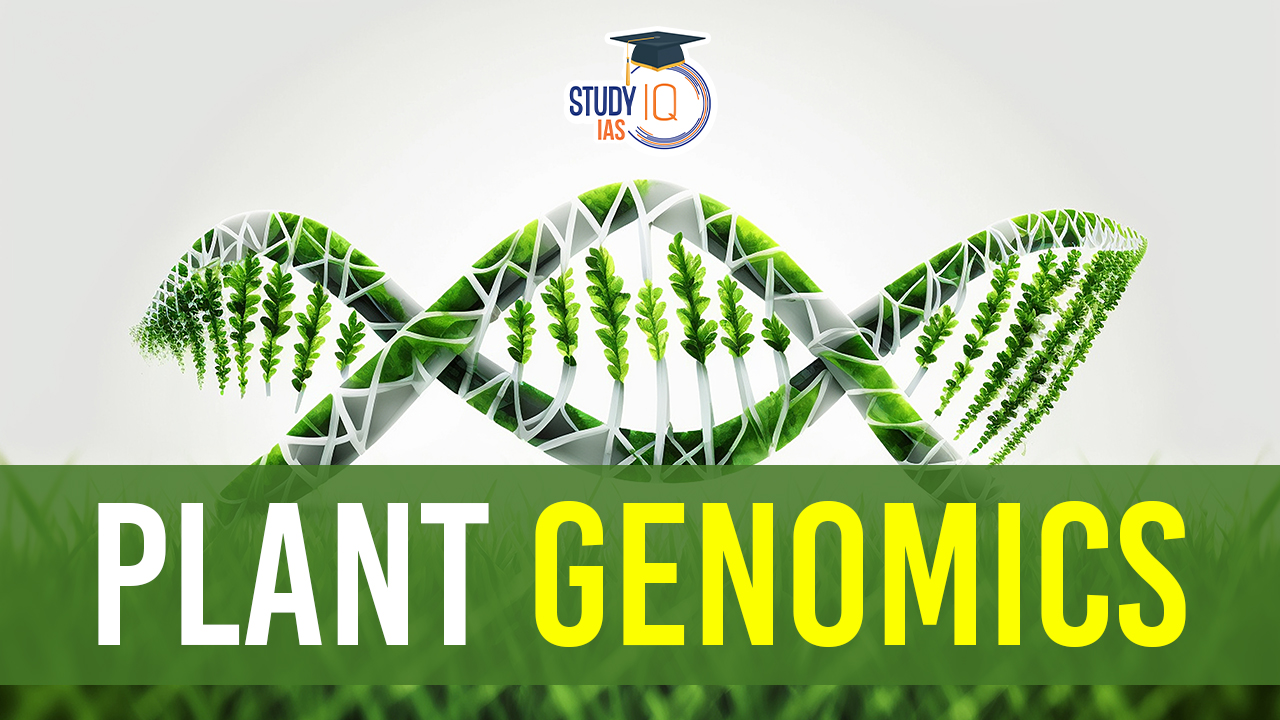Table of Contents
Plant genomics is a branch of genomics that focuses on the study of the genetic makeup of plants. It involves the analysis and characterization of the entire set of genes (the genome) present in plants, including their organization, structure, function, and interactions. Plant genomics aims to understand the genetic basis of plant traits, growth, development, and response to environmental factors. This field has applications in agriculture, plant breeding, and biotechnology.
Plant Genomics
Plant genomics is the study of the genetic material of plants, encompassing their entire DNA sequences and associated traits. This field explores the structure, function, evolution, and interactions of genes within plant genomes. By decoding plant genomes, scientists gain insights into plant biology, enabling advancements in crop improvement, sustainable agriculture, and the understanding of plant adaptation to environmental challenges.
We’re now on WhatsApp. Click to Join
Key Aspects of Plant Genomics
Genome Sequencing
Genome sequencing is the process of determining the complete DNA sequence of an organism’s genome. This includes identifying the order of nucleotide bases (adenine, thymine, cytosine, and guanine) that make up an organism’s DNA. This breakthrough technology has revolutionized various scientific fields and applications.
The genome sequence provides a comprehensive blueprint of an organism’s genetic information, unlocking insights into its structure, function, and evolution. It plays a crucial role in fields such as medicine, agriculture, and environmental science. In medicine, genome sequencing aids in understanding genetic factors underlying diseases, enabling personalized medicine approaches. In agriculture, it facilitates crop improvement by identifying desirable traits and accelerating breeding programs. Environmental scientists use genome sequencing to study microbial communities and biodiversity.
Technological advancements, such as next-generation sequencing, have significantly reduced the cost and time required for genome sequencing. This progress has paved the way for large-scale projects, contributing to our understanding of the diversity and complexity of life on Earth.
Functional Genomics
Functional genomics is a branch of molecular biology that investigates the functions and interactions of genes within an organism. It aims to understand how genetic information is translated into the functional elements that govern cellular processes. This field employs various experimental and computational approaches to study gene function, including gene expression profiling, functional assays, and the manipulation of genes to observe the resulting phenotypic changes.
Techniques like CRISPR-Cas9 have revolutionized functional genomics by enabling precise gene editing, allowing researchers to selectively activate or deactivate specific genes. Functional genomics provides critical insights into the roles of genes in normal development, disease processes, and responses to environmental stimuli. By unraveling the complex networks of gene interactions, functional genomics contributes to advancements in medicine, agriculture, and biotechnology.
Comparative Genomics
Comparative genomics is a field of study that involves comparing the DNA sequences and structures of genomes from different species. The goal is to identify similarities and differences to gain insights into evolutionary processes, genetic variation, and functional elements. By examining the genomic content and organization across species, researchers can infer evolutionary relationships, trace the origins of genes, and understand the genetic basis of traits.
This field utilizes computational tools and bioinformatics to analyze large-scale genomic data. Comparative genomics helps identify conserved regions, gene families, and regulatory elements, shedding light on fundamental biological processes. It is instrumental in understanding the genetic basis of adaptation, speciation, and the diversity of life forms.
Comparative genomics has practical applications in medicine, where it aids in identifying conserved genes associated with diseases, and in agriculture, where it informs breeding programs by revealing genetic variations responsible for desirable traits. This interdisciplinary approach enhances our understanding of the intricate connections between genotypes and phenotypes across the tree of life.
Epigenomics
Epigenomics is a field of study that investigates the complete set of epigenetic modifications within an organism. Epigenetics involves changes to the genome that affect gene expression without altering the underlying DNA sequence. These modifications include DNA methylation, histone modification, and non-coding RNA molecules. Epigenomics aims to map and understand these modifications on a genome-wide scale.
This field plays a crucial role in unraveling complex biological phenomena such as development, aging, and diseases. Epigenetic modifications can influence cellular differentiation, responses to environmental cues, and the regulation of genes involved in various physiological processes. Dysregulation of epigenetic mechanisms is associated with numerous diseases, including cancer and neurological disorders.
Technological advancements, such as next-generation sequencing, have enabled researchers to study epigenetic modifications on a genome-wide scale, leading to a more comprehensive understanding of how these modifications contribute to normal cellular functions and disease states. Epigenomics has broad implications in medicine, as it provides potential targets for therapeutic interventions and offers insights into personalized medicine approaches based on an individual’s epigenetic profile.
Transcriptomics
Transcriptomics is a branch of molecular biology that focuses on the study of the complete set of RNA transcripts (the transcriptome) produced by the cells of an organism. This includes messenger RNA (mRNA), which carries the genetic information from DNA to the ribosomes for protein synthesis, as well as various non-coding RNAs that play regulatory roles in gene expression.
The primary goal of transcriptomics is to understand the patterns and levels of gene expression under different conditions or in various tissues. Researchers use techniques such as RNA sequencing (RNA-Seq) to analyze and quantify the abundance of RNA molecules. Transcriptomic studies provide insights into the dynamics of gene expression, including which genes are active, their levels of expression, and how expression patterns change in response to environmental stimuli, developmental stages, or diseases.
By deciphering the transcriptome, scientists can uncover the molecular mechanisms underlying biological processes, identify key regulatory pathways, and discover potential biomarkers for various conditions. Transcriptomics has broad applications in fields such as medicine, agriculture, and environmental science, contributing to our understanding of complex biological systems and facilitating the development of targeted therapeutic strategies.
Metagenomics
Metagenomics is a field of genomics that involves the study of genetic material recovered directly from environmental samples, which can include complex communities of microorganisms. Unlike traditional genomics, which focuses on the genomic analysis of individual organisms, metagenomics looks at the collective genetic material of all the organisms within a particular habitat.
This approach enables the exploration of microbial diversity, functional capabilities, and ecological interactions within complex ecosystems, such as soil, water, or the human gut. Metagenomic studies involve the extraction of DNA from a sample, followed by high-throughput sequencing and bioinformatics analysis to characterize the microbial community’s genetic composition.
Metagenomics has wide-ranging applications, including environmental monitoring, understanding microbial community dynamics, and identifying novel genes and enzymes with potential industrial or medical applications. It has been instrumental in revealing the vast and previously unexplored genetic diversity present in various ecosystems, contributing to our understanding of the role microorganisms play in maintaining ecosystem health and functioning. Additionally, metagenomics plays a crucial role in fields like medicine, where it aids in studying the human microbiome and its impact on health and disease.
Applied Genomics in Agriculture
Applied genomics in agriculture refers to the practical application of genomic information and technologies to enhance crop production, improve agricultural sustainability, and address challenges related to food security. This field leverages genomic insights to understand and manipulate the genetic makeup of crops for desired traits, ultimately optimizing agricultural practices. Key aspects of applied genomics in agriculture include:
Crop Improvement: By identifying and manipulating genes associated with desirable traits such as yield, resistance to diseases, and tolerance to environmental stresses, applied genomics accelerates traditional breeding programs. This leads to the development of improved crop varieties with enhanced productivity and resilience.
Precision Agriculture: Genomic data allows for precision farming practices, where resources such as water, fertilizers, and pesticides are used more efficiently. Tailoring agricultural practices to the specific genomic characteristics of a crop helps optimize yields while minimizing environmental impact.
Disease Resistance: Understanding the genetic basis of plant diseases enables the development of crops with enhanced resistance. This can reduce the reliance on chemical pesticides, promoting sustainable and environmentally friendly agriculture.
Nutritional Enhancement: Genomic insights can be applied to enhance the nutritional content of crops, addressing malnutrition and improving the overall quality of food produced. This is particularly important in regions where certain nutrients are deficient in staple crops.
Climate Resilience: Applied genomics contributes to the development of crops that are better adapted to changing climate conditions. This involves identifying genes associated with traits like drought tolerance or heat resistance, helping farmers mitigate the impact of climate change on crop yields.
Genetically Modified Organisms (GMOs): While controversial, genetic modification based on genomics has been used to introduce specific traits into crops, such as resistance to pests or herbicides. This technology can enhance crop yields and reduce the need for certain chemical inputs.
Data-Driven Agriculture: The integration of genomic data with other agricultural data sources in a digital farming approach allows for more informed decision-making. Farmers can utilize this information for precise planting, monitoring, and management of crops.
Applied genomics in agriculture holds the potential to address global food security challenges by providing innovative solutions to optimize crop production and mitigate the impact of environmental factors on agriculture. However, ethical considerations, environmental impact assessments, and public acceptance are crucial aspects that need to be carefully addressed in the deployment of these technologies.
Bioinformatics
Bioinformatics is an interdisciplinary field that combines biology and computer science to analyze and interpret biological data. It involves the development and application of computational techniques, statistical methods, and information technologies to gather, process, and analyze biological information. Key aspects of bioinformatics include:
Genome Analysis: Bioinformatics plays a crucial role in the analysis of genomic data, including DNA sequencing. It involves the assembly, annotation, and comparison of genomes to understand the structure, function, and evolution of genes and entire genomes.
Proteomics: Bioinformatics tools are used to analyze and interpret data from protein studies, including protein structure prediction, identification of functional domains, and understanding protein-protein interactions.
Transcriptomics: Analyzing data from high-throughput sequencing methods, such as RNA-Seq, bioinformatics helps researchers understand gene expression patterns, alternative splicing, and regulatory mechanisms at the transcriptome level.
Metagenomics: Bioinformatics is essential for the analysis of complex microbial communities in environmental samples. It involves the identification of species, functional genes, and metabolic pathways present in these communities.
Structural Biology: Bioinformatics tools are employed to predict and analyze the three-dimensional structures of biological macromolecules, such as proteins and nucleic acids. This aids in understanding their functions and interactions.
Pharmacogenomics: Bioinformatics is used to study genetic variations in individuals that may influence responses to drugs. This information helps in personalized medicine by tailoring drug treatments to individual genetic profiles.
Systems Biology: Bioinformatics contributes to the integration of data from various omics disciplines to understand the complex interactions within biological systems. This holistic approach helps in modeling and simulating biological processes.
Data Mining and Analysis: Bioinformatics involves the development of algorithms and computational tools for mining large biological datasets. This includes identifying patterns, correlations, and meaningful biological information from massive amounts of genomic and proteomic data.
Evolutionary Biology: Bioinformatics is employed to study the evolutionary relationships between species by analyzing genetic sequences. Phylogenetic analysis and comparative genomics help reconstruct the evolutionary history of organisms.
Clinical Bioinformatics: In the medical field, bioinformatics is applied to analyze clinical and molecular data for disease diagnosis, prognosis, and treatment selection. It plays a critical role in understanding the genetic basis of diseases and developing targeted therapies.
Bioinformatics has become an integral part of modern biological research, enabling scientists to process and interpret vast amounts of biological data. As technology advances and biological datasets continue to grow, bioinformatics will remain essential for extracting meaningful insights from complex biological information.
Plant Genomics Advantages
- Crop Enhancement: Plant genomics identifies genes for improved traits like yield, disease resistance, and stress tolerance, expediting traditional breeding.
- Precision Breeding: Genomic insights enable targeted breeding for specific traits, enhancing efficiency in developing crops with desired characteristics.
- Disease Resistance: Understanding the genomic basis of plant diseases aids in developing resistant varieties, and reducing dependence on pesticides for sustainable agriculture.
- Abiotic Stress Tolerance: Genomics identifies genes involved in stress response, contributing to the development of resilient crops capable of thriving in challenging conditions.
- Nutritional Improvement: Uncovering nutritional genes enhances crops’ nutritional content, addressing malnutrition and improving the quality of staple foods.
- Biodiversity Conservation: Plant genomics helps conserve genetic diversity within species, crucial for long-term crop adaptation and improvement.
- Accelerated Breeding: Genomic tools like marker-assisted selection and genomic selection speed up breeding, reducing the time to develop new crop varieties.
- Biotechnological Applications: Genomic insights drive biotechnological advancements, including the development of genetically modified crops with specific traits.
- Understanding Plant Physiology: Genomics unravels molecular mechanisms governing plant growth, development, and responses to environmental cues.
- Data-Driven Agriculture: Integration with precision agriculture and data analytics allows farmers to make informed decisions, optimizing resource management and crop protection.
Plant Genomics UPSC
Plant genomics is a comprehensive study of plant genetic material, exploring DNA sequences and associated traits. It encompasses genome sequencing, functional genomics, comparative genomics, epigenomics, transcriptomics, and metagenomics. These approaches provide insights into plant biology, aiding advancements in agriculture, crop improvement, and environmental adaptation. Applied genomics in agriculture utilizes these insights for crop enhancement, disease resistance, nutritional improvement, and climate resilience. Bioinformatics is integral for data analysis. Plant genomics offers numerous advantages, including accelerated breeding, biodiversity conservation, and the potential for data-driven agriculture, contributing to sustainable and optimized crop production.


 Genetically Modified Crops in India, Reg...
Genetically Modified Crops in India, Reg...
 What are Polycyclic Aromatic Hydrocarbon...
What are Polycyclic Aromatic Hydrocarbon...
 MALE Class Drones: Capabilities, Payload...
MALE Class Drones: Capabilities, Payload...





















